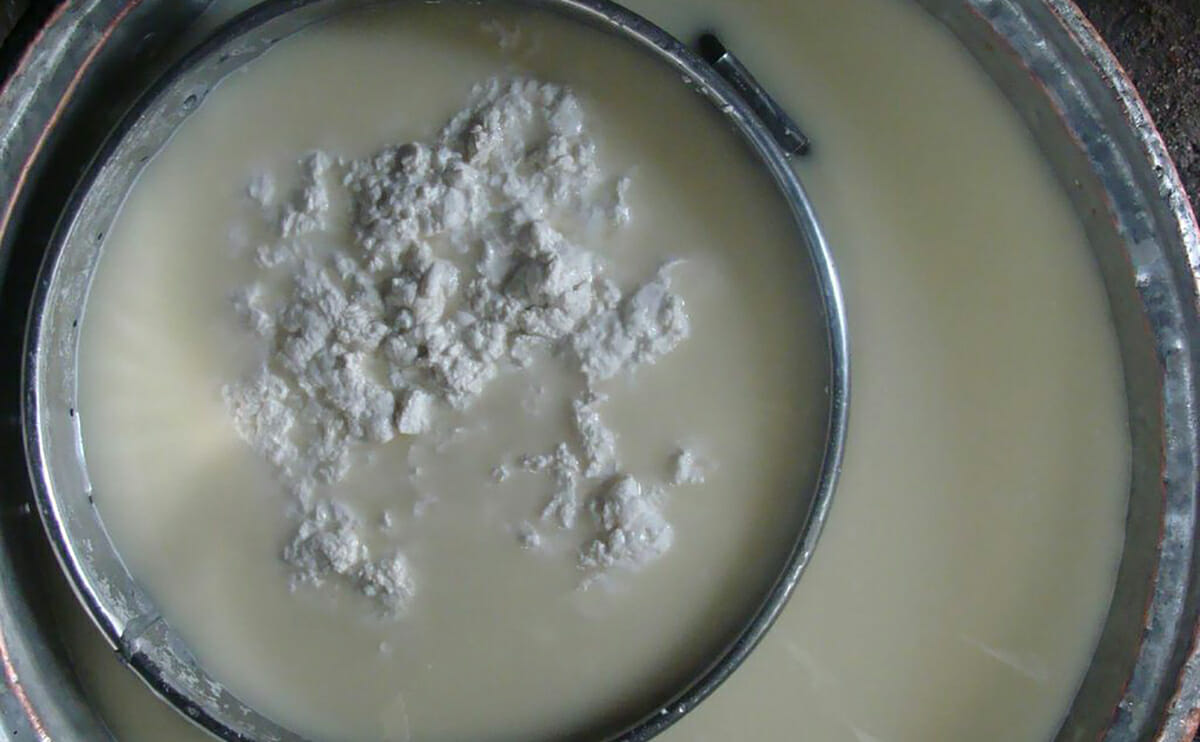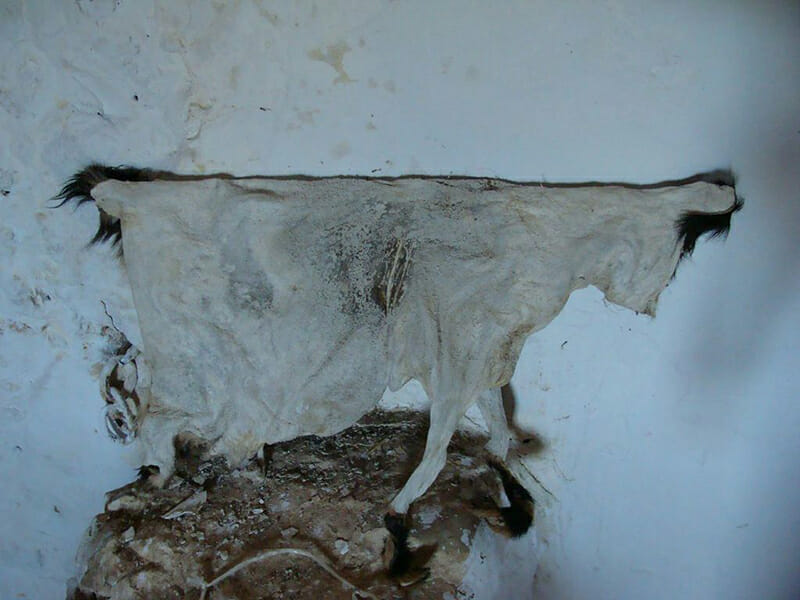Why Not Dig Into Some Skin Cheese?
One woman’s search for an authentic Greek cheese that’s aged in the skin of a goat.
Why Not Dig Into Some Skin Cheese?
One woman’s search for an authentic Greek cheese that’s aged in the skin of a goat.

Unlike Polyphemus, most shepherds in our region are nomadic, following those ancient monopatia each spring and fall, thus they have had to forgo cave-aging in favor of a more portable solution. Since ancient times, and in other parts of the world, too, that solution has come in the form of the cleaned and heavily salted skin of a goat or a sheep – the perfect vessel for the storage of milk and the aging of cheese.
In Greece, this cheese is commonly called touloumotiri, from touloumi, modern vernacular Greek for the skin of the animal, and tiri, which means “cheese.” Until a few decades ago, it was easy to find touloumotiri in the touloumi throughout Greece. You could purchase it directly from the cheesemaker or at the butcher’s or corner market. Today, many cheesemakers produce a cheese they call touloumotiri, but few use animal skins, forgoing that tradition in favor of wooden or plastic barrels.

Barrel-aged touloumotiri is the cheese I taste most often in the home cooking of my neighbors, and with good reason: Compared to factory-made feta, locally-made touloumotiri is inexpensive. Moreover it is delicious. When fresh, it is soft and moist and has an earthy, creamy flavor. Over time, the cheese dries and hardens, and its flavor sharpens considerably.
But friends have told me that real touloumotiri, the stuff produced in the touloumi, is even better. That a blue mold forms between the cheese and the skin, which the cheesemaker or shopkeeper will, from time to time, knead into the cheese. That the result of this mold is a deliciously pungent and peppery flavor – one that makes your mouth water. After hearing these descriptions over and over again, often told with a certain sense of melancholy and longing, I became curious about touloumotiri produced in the touloumi. Are there any cheesemakers who still produce the real thing, I wondered? If so, why? And, if so, just how do they do it? Finally, I thought to myself, the cheese is made in the skin of an animal? That sounds weird – how can it really be so good?
And so I set off on a hunt for real touloumotiri, but from the beginning the leads were few. “The touloumi left when electricity came to the village,” one cheesemaker told me. “But that was just ten years ago,” I retorted. “Siga, (slow down),” she said, “and have another ouzo.”
But I carried on and eventually I learned through a friend on a neighboring island that a shop in her village carried touloumotiri in the touloumi. When she asked the shopkeeper about the cheese, he replied that its producer lived “somewhere above Monemvasia,” a town on the southeastern coast of the Peloponnese. When I called the shopkeeper for more details, he told me that the cheesemaker lived “somewhere outside of Sparti,” and he couldn’t remember exactly where. After that, I tried to ignore the question of the touloumi, but every time I sat down to eat a salad or a pita, there it was, staring me in the face. I had to find touloumotiri in its native habitat, the touloumi.
Cheesemaker Dimitris Hiotis holds a touloumi (the skin of a goat), which he will invert and then fill with cheese. The cheese will age in the skin for six months or more.
Draining the whey in the Hiotis cheesemaking room in the mountains of Greece.
Dimitris Hiotis knots the legs of the touloumi to create a vessel for the aging and storage of touloumotiri.
My search was long and circuitous, taking me to people and places far from my own village. To Monemvasia and Sparti, yes, and to other towns and villages, too. To butchers’ and cheese shops. To warm kitchens in midwinter, and sweltering farms in midsummer.
In the end, I found the cheese – made in the touloumi – in an all but abandoned shepherd’s village a long and hot walk up a steep mountainside not far from home. Was the cheese good? You bet it was. It was delicious and pungent, just as my friends had described, but it was even better than they’d described, despite the more-than-occasional goat hair I’d encounter in the eating of it.
The cheese was even better than they’d described, despite the more-than-occasional goat hair I’d encounter.
But, really, why all the fuss over cheese? Moreover, why all the fuss over skin-aged cheese? In the process of all of my searching and talking to cheesemakers, shepherds and others, in the process of hearing their memories of eating touloumotiri from the touloumi, of the foods they ate with it, of the artisans who made it, the cheese gradually became a symbol of what I love about the people and foodways of the rural Peloponnese, and a bigger story emerged – a story about tradition, about memory, about history and about sustainability. A story about the fact that, although some customs, like the practice of storing and aging cheese in the skin of an goat, have gone by the wayside, many of our region’s ancient food traditions are still very much alive today. And every time I sit down to eat, this story is with me. Every time I shop – from the green grocer, from the butcher, from the baker, I do so with a not-so-subtle appreciation that nearly every product I buy here was produced by a person with a first and last name, not a corporation. Moreover, nearly every product I buy was produced by someone I can very likely find within a few minutes’ or hours’ drive from my home. And, in today’s world, that’s pretty rare.
So, I’ll take a slice of touloumotiri from the touloumi, even if there’s a bit of goat hair in it. Ideally with a hunk of my neighbor’s homemade bread and a glass of a friend’s heady, handmade wine. I think even Polyphemus would agree, that’s food worth fussing over.
Follow us

This work is licensed under a Creative Commons Attribution-NoDerivatives 4.0 International License.
Want to republish a Modern Farmer story?
We are happy for Modern Farmer stories to be shared, and encourage you to republish our articles for your audience. When doing so, we ask that you follow these guidelines:
Please credit us and our writers
For the author byline, please use “Author Name, Modern Farmer.” At the top of our stories, if on the web, please include this text and link: “This story was originally published by Modern Farmer.”
Please make sure to include a link back to either our home page or the article URL.
At the bottom of the story, please include the following text:
“Modern Farmer is a nonprofit initiative dedicated to raising awareness and catalyzing action at the intersection of food, agriculture, and society. Read more at <link>Modern Farmer</link>.”
Use our widget
We’d like to be able to track our stories, so we ask that if you republish our content, you do so using our widget (located on the left hand side of the article). The HTML code has a built-in tracker that tells us the data and domain where the story was published, as well as view counts.
Check the image requirements
It’s your responsibility to confirm you're licensed to republish images in our articles. Some images, such as those from commercial providers, don't allow their images to be republished without permission or payment. Copyright terms are generally listed in the image caption and attribution. You are welcome to omit our images or substitute with your own. Charts and interactive graphics follow the same rules.
Don’t change too much. Or, ask us first.
Articles must be republished in their entirety. It’s okay to change references to time (“today” to “yesterday”) or location (“Iowa City, IA” to “here”). But please keep everything else the same.
If you feel strongly that a more material edit needs to be made, get in touch with us at [email protected]. We’re happy to discuss it with the original author, but we must have prior approval for changes before publication.
Special cases
Extracts. You may run the first few lines or paragraphs of the article and then say: “Read the full article at Modern Farmer” with a link back to the original article.
Quotes. You may quote authors provided you include a link back to the article URL.
Translations. These require writer approval. To inquire about translation of a Modern Farmer article, contact us at [email protected]
Signed consent / copyright release forms. These are not required, provided you are following these guidelines.
Print. Articles can be republished in print under these same rules, with the exception that you do not need to include the links.
Tag us
When sharing the story on social media, please tag us using the following: - Twitter (@ModFarm) - Facebook (@ModernFarmerMedia) - Instagram (@modfarm)
Use our content respectfully
Modern Farmer is a nonprofit and as such we share our content for free and in good faith in order to reach new audiences. Respectfully,
No selling ads against our stories. It’s okay to put our stories on pages with ads.
Don’t republish our material wholesale, or automatically; you need to select stories to be republished individually.
You have no rights to sell, license, syndicate, or otherwise represent yourself as the authorized owner of our material to any third parties. This means that you cannot actively publish or submit our work for syndication to third party platforms or apps like Apple News or Google News. We understand that publishers cannot fully control when certain third parties automatically summarize or crawl content from publishers’ own sites.
Keep in touch
We want to hear from you if you love Modern Farmer content, have a collaboration idea, or anything else to share. As a nonprofit outlet, we work in service of our community and are always open to comments, feedback, and ideas. Contact us at [email protected].by Alexis Adams, Modern Farmer
August 8, 2014
Modern Farmer Weekly
Solutions Hub
Innovations, ideas and inspiration. Actionable solutions for a resilient food system.
ExploreExplore other topics
Share With Us
We want to hear from Modern Farmer readers who have thoughtful commentary, actionable solutions, or helpful ideas to share.
SubmitNecessary cookies are absolutely essential for the website to function properly. This category only includes cookies that ensures basic functionalities and security features of the website. These cookies do not store any personal information.
Any cookies that may not be particularly necessary for the website to function and are used specifically to collect user personal data via analytics, ads, other embedded contents are termed as non-necessary cookies.